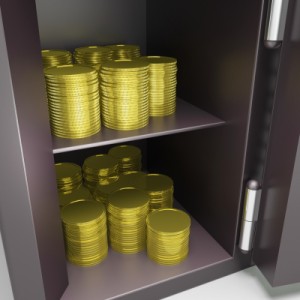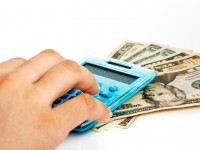Two years of living expenses in a savings account: that’s what my cash reserves plan amounted to a few months ago. Then I started planning to write a blog post on the how and why of that plan. And in so doing, completely changed my thinking.
I’ve gone from a cash reserves plan to an emergency reserves plan — and that has made a huge difference. Before, my cash reserves consisted of sums in checking, savings and CD accounts amounting to (as I said) 2 years of living expenses. Now, my emergency reserves consist of a 6-month food supply, $2000 cash on hand, gold and silver coins on hand, a year’s worth of living expenses in cash deposit accounts, and $270,000 in personal credit lines from 13 different financial institutions. This madeover emergency reserves plan is much much broader in scope than my old cash reserves plan — yet ties up less money. And the freed money can now be invested for extra income.
This emergency reserves plan works for me thanks to my own individual income and insurance framework. The plan’s specifics are not going to be applicable to someone else’s financial situation. But the thinking behind the plan may very well open some mental doors worth opening. You decide.
What are my reserves supposed to do?
My reserves are there to give me liquidity and solvency. I don’t want to be forced to sell a chunk of my investments (at the wrong time!) because I need the ready cash (liquidity). I don’t want to have to do without something I need (such as a car repair or a medical prescription) because I just don’t have the money (solvency). I don’t want my credit score to plunge because I don’t have enough money in my checking accounts to pay my bills when they come due (liquidity and solvency). And I don’t want to miss out on an investment/savings/great deal opportunity because I don’t have the necessary funds when the opportunity presents itself.
BUT! In the first place, I don’t need money in a checking or savings account to deal with some of those situations. And in the second place, there are plenty of situations where money in a checking or savings account (or available balance on a credit card) would not do me one bit of good.
To give myself true (or truer) liquidity and solvency, I’ve had to revise the elements of my reserve so that I will be covered in a much wider range of possible emergency situations.
What I learned about ready cash from Hurricane Andrew
There are a lot of things I’m never going to forget about the aftermath of Hurricane Andrew in Miami. And one of those things is the little convenience store that reopened up for business a few blocks from me just 2 days after the hurricane hit. There was no electrical power in that entire section of the city, so: no electronic cash registers, no credit card terminals, and no ATMs. Cash was King and prices were inflated. Almost 2 weeks passed before that little store had its electrical power restored. Same thing for the home improvement store half-a-mile in the other direction. If you were out of cash, you were out of luck. And that in a situation where you even had to buy your water because there was nothing coming out of the faucets!
So, Reserves Lesson #1 for me: have a ready cash reserve at home.
But for some people in the areas south of Miami, it was actually worse than that. There were no stores in good enough shape to open and NOTHING to buy. We all saw similar images repeat themselves a few years later in New Orleans. People standing in line for food-and-water handouts from the back of trucks. People completely at the mercy of… whatever.
Something like that can happen anywhere, anytime. Hurricane… earthquake… forest fire… tornado… snow storm… civil disturbance… security lockdown (think Boston)… you name it. The day could come when you have no open stores to go to. For days. If it’s really, really bad maybe for weeks. All you’ll have is what’s in your pantry. (Best to go right through the stuff in your refrigerator the first day, before it all spoils.)
So, Reserves Lesson #2 for me: have a food reserve at home.
What I hope I never learn first hand about the fragility of fiat money
Emergency is the key operating premise in my approach to reserves. And what could be more of a financial emergency than your money becoming worthless, or just disappearing overnight from your accounts?
Last year, Cyprus tried to simply confiscate bank deposits above a certain amount. My Cuban friend lived through a day when — overnight — the paper currency was changed and no one was allowed to exchange more than a certain limited amount of the old no-longer-legal-tender money (or bank deposits) for the new paper. That scenario has been played many times in many different countries. And how do I know it won’t happen here?
I hope it does not happen. More than that, I don’t think it will happen. But even though I don’t expect my house to burn down, I have homeowner’s insurance in case the unthinkable happens. Even though I don’t expect my vehicle to get totaled on the highway by some tipsy driver, I have automobile insurance in case the unthinkable happens. And, even though I don’t expect some currency-collapsing crisis to happen here, I think I better have at least a little insurance in case the unthinkable happens.
So, Reserves Lesson #3 for me: have a modest stash of gold and silver coins at home. (And if nothing happens, it will just have been another investment.)
The rest is just a matter of hedging my cash flow
As I mentioned earlier, this emergency reserves plan works for me thanks to my own individual income and insurance framework. And that framework makes it very unlikely that I could get caught in a longterm cash flow crunch.
My Social Security income covers 110% of my basic living expenses. Dividends and interest income from my investment portfolio covers 180% of my basic living expenses. That means that my retirement income could collapse by 60% and I still would not have to fight Sassy, Scampy and Bear for their canned cat food. I cannot see a solvency issue in my horizon; just the possibility of a liquidity one.
And that is where my credit lines come in as a component of my emergency reserves plan. Except for taxes, electricity, and insurance, all my expenses could be paid by credit card if necessary. Having credit lines from 13 different banks gives me a way to bridge any short term lack of liquidity for more than half of my living expenses without having to be dependent on just one or two lenders. I can always pay off any borrowed sums with future cash flow from my Social Security and/or my investment income.
The other “cash only” half of my basic living expenses needs to be covered by, well, cash. So I have hedged that with a year’s worth of those expenses in a checking and a savings account.
So, Reserves Lessons #4 and #5 for me: keep a diversified mix of credit lines open, and keep enough money in bank deposits to cover your non-chargeable expenses for a reasonably long while.
The only possible fly that could still be left in the ointment here would be unexpected medical expenses. But I think I have covered that too. I’ve focused on overall worst case medical expense risk to come up with a maximum possible expense number ($5000 a year) that I could most certainly handle under my emergency reserves plan.
The takeaway: With this emergency reserves plan in place, I have reduced my need for cash reserves by a lot. As a result of investing the freed funds, I have boosted my annual passive income by a goodly amount. And I have hedged against just about every kind of emergency I can think of. So, more emergency coverage and more money in my pocket. It is all good!
# # #
image: courtesy of Stuart Miles at FreeDigitalPhotos.net








I have for awhile wanted to own some physical gold. What would your recommend as a solid place to purchase.
Thanks in advance
Well, I would not normally put out a plug for anyone but since you’ve asked. I’ve had good luck with Provident Metals. You can find them on the web.
Good plan – have you made any adjustments since then?
Living in Florida certainly calls for extra measures that’s for sure. Just reviewed our food stash and added new batteries and checked on water supplies. Need to make time this coming week for a full inventory – what we don’t rotate from the food stash and is near expiration is donated each year to the Mail Carriers campaign so I don’t feel like I wasted the food. Of course the kitties love me around inventory time since there’s always an extra can of real tuna for them:)
Not quite there in the cash department yet (almost half way there) and recently got a surprise gift of some gold coins.
Having cash at home is a must in case of evacuation, bank might be closed and their ATM out of cash — if it works at all.
I admit after Katrina – I went into overdrive and we now have things like tarps and a well stocked first aid kit along with Vodka and a slew of other essentials – just in case.
A solar powered charger is still on my wish list.
Rose, it never hurts to be more prepared. So don’t second-guess yourself about the steps you have taken.
And, yes, actually, since I wrote that post I have revamped the cash-in-the-bank part of my plan. I realized I wasn’t taking into account as much of my incoming cash streams as I should have. So now I’ve reduced my bank emergency reserve to $10,000.